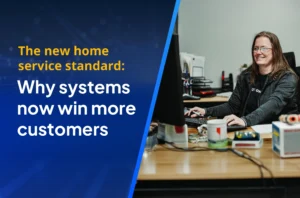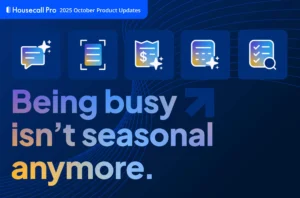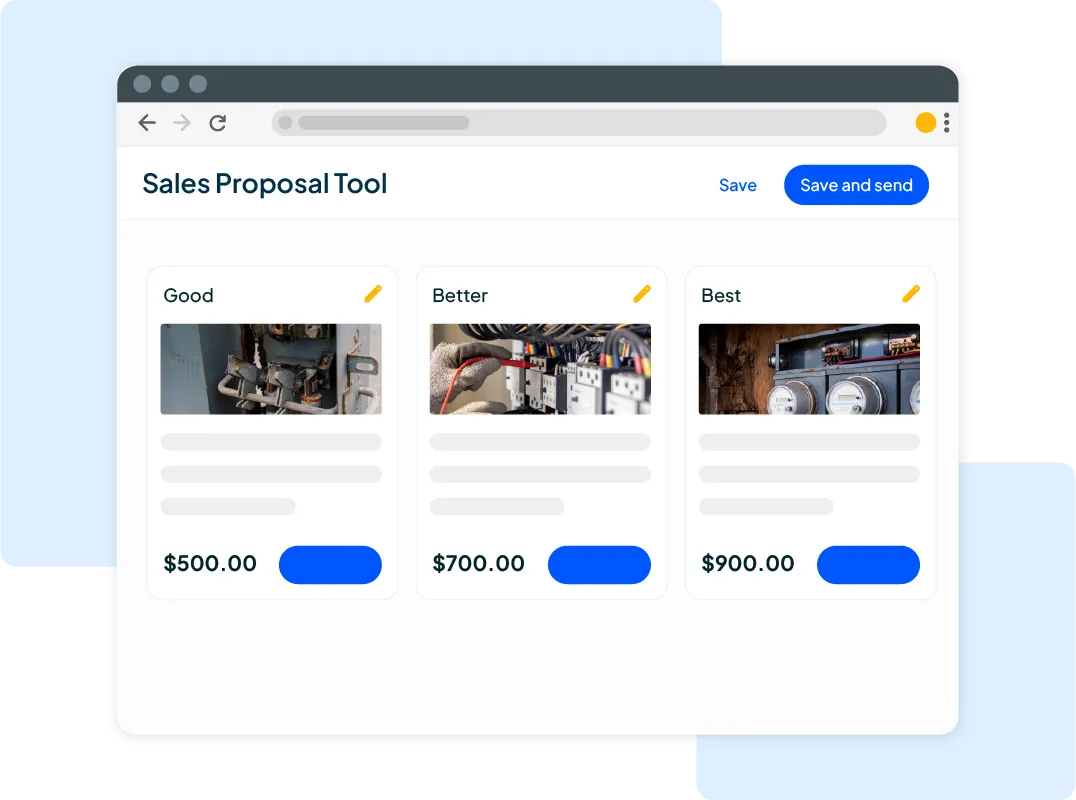Want to win more jobs with less effort?
Grow your business and send quick quotes with our home service software.

Want to see your potential revenue?
See what businesses like yours earn with Housecall Pro in 1 - 2 minutes.

Pricing isn’t just about numbers—it’s a core part of your business strategy. For home service pros, the way you price your services impacts everything: how customers perceive your brand, how competitive you are in the market, and how reliably you generate profit. A smart pricing strategy helps you work more efficiently, boosts your earnings, and builds lasting customer relationships.
We’ve pulled together 12 proven service pricing strategies to increase your profit margins and build trust. Each one has different benefits and challenges depending on your trade, customer base, and business goals. This article will walk you through when each approach works best so you can find the right fit and price your services with confidence.
- 1. Flat rate pricing: predictability for you and your customers
- 2. Hourly pricing: flexibility for variable jobs
- 3. Project-based pricing: clarity for defined scopes
- 4. Tiered pricing: offering choices to fit different budgets
- 5. Bundled services: adding value through packages
- 6. Market penetration pricing: gaining a foothold
- 7. Premium pricing: positioning as a high-value provider
- 8. Dynamic pricing: adjusting to market conditions
- 9. Value-based pricing: charging based on perceived worth
- 10. Cost-plus pricing: covering costs and ensuring profit
- 11. Psychological pricing: influencing perception through pricing
- 12. Competitive pricing: staying in line with market rates
- How to choose the right pricing strategy for your service business
- Leveraging digital tools to set a competitive pricing strategy
1. Flat rate pricing: predictability for you and your customers
Flat rate pricing involves charging a fixed price for a job, no matter how long it takes. It’s predictable and offers transparency that helps build customer trust. This is a great choice for industries with routine services, like HVAC and plumbing, but it may not be the best fit for more unpredictable jobs, like custom remodels or hard-to-diagnose appliance repairs.
Tools like Housecall Pro’s price book can help you build a list of consistent, transparent prices that are simple and scalable. It allows you to build out line items with materials, labor, and job-specific details to generate quotes faster and more accurately.
| Pros | Cons |
|---|---|
| Easy for customers to understand without needing fine print | Doesn’t cover surprises or scope changes that eat into time |
| Fewer billing disputes, thanks to upfront transparency | Potential to undercharge if a job runs longer than expected |
| Motivates faster job completion to protect your margins | Requires strong estimating skills to get pricing right |
Best suited for:
- HVAC
- Plumbing
- Electrical
- Similar industries with predictable services
2. Hourly pricing: flexibility for variable jobs
Hourly pricing is the complete opposite of flat rate pricing. It lets you charge for the actual time you spend on a job, which is ideal when the scope isn’t clear from the start. It works well for situations like repairs that turn out to be more complex than expected or custom projects with lots of moving parts.
However, it can make some customers nervous about how high the final bill might climb. Being transparent about rates and using time-tracking tools, like Housecall Pro’s time-tracking feature, goes a long way in helping your customers understand where your time (and their money) is going.
| Pros | Cons |
|---|---|
| Straightforward billing based on time actually spent | Customers might be wary of escalating costs |
| Flexible for varying job scopes or unexpected issues | Requires every team member to log their time accurately, which isn’t always guaranteed |
| Gives customers more visibility into what they’re paying for, especially on longer or more complex jobs | May discourage speed and efficiency among technicians over time |
Best suited for:
- Repairs
- Consulting
- One-off tasks
3. Project-based pricing: clarity for defined scopes
Project-based pricing means you quote one price for the entire job, from start to finish. This works great when you have a clear scope and timeline, and both you and your customer know exactly what needs to get done.
Unlike flat-rate pricing, which usually applies to a single task or service, project-base pricing covers a full job with multiple services or phases included in one set price. This model helps eliminate surprises, making it easier for your customers to plan their budget and for you to stay on top of your schedule. Just be sure to keep an eye on scope creep. Making several seemingly inconsequential changes to the plan can quickly throw you off track if you’re not careful.
| Pros | Cons |
|---|---|
| Helps customers budget confidently with fewer unknowns | If the project changes, you’ll need to rescope and reprice |
| Keeps expectations clear on both sides of the job | Unexpected delays can eat into profits or schedules |
| Makes scheduling and planning easier on your end | Can be risky if scope creep isn’t tightly managed |
Best suited for:
- Remodeling
- Landscaping
- Large installations
4. Tiered pricing: offering choices to fit different budgets
With tiered pricing, you offer clear service levels (think Good, Better, Best) so customers can choose the option that fits their needs and budget. It sets clear expectations around cost and scope, making it easier for customers to understand your pricing and feel in control of their purchase.
It also gives you a built-in upsell path. When customers see the value in your higher tiers, they’re more likely to up their service level (especially when each tier is clearly laid out and well differentiated).
| Pros | Cons |
|---|---|
| Allows you to broaden your customer base by catering to different budgets | Tiers must be clearly defined to avoid confusion |
| Makes upselling easier by showcasing added value | Too many choices can overwhelm customers and stall decisions |
| Helps customers feel in control of their choices | Takes time and strategy to design well-balanced tiers |
Best suited for:
- Cleaning services
- Maintenance plans
- Subscriptions
5. Bundled services: adding value through packages
Bundling means grouping related services together under a single price—for example, offering an HVAC tune-up, air filter replacement, and duct cleaning as a seasonal maintenance package. This makes your offer feel like a better deal and often leads customers to buy more services than they would have otherwise.
Bundling also streamlines the decision-making process for your customers. Instead of picking from a menu of one-off services, they can choose a package that covers everything they need, saving time, reducing confusion, and creating a smoother experience overall.
| Pros | Cons |
|---|---|
| Boosts the average order total | May reduce flexibility for customers seeking specific services |
| Simplifies buying decisions for customers | Requires careful pricing to maintain profitability across bundles |
| Encourages repeat business through packaged value | Can undervalue services if bundles aren’t structured correctly |
Best suited for:
- Home maintenance
- Seasonal services
- Recurring appointments
6. Market penetration pricing: gaining a foothold
Using low prices when you first break into a new market can be a smart way to gain momentum quickly. It helps garner attention, win new business, and give people a reason to try your services.
Once your reputation is established and demand picks up, you can slowly raise your prices to match the value you bring. When that time comes, communicate pricing updates clearly so customers know what to expect and why.
Start by introducing service tiers or bundling in added value, like extended warranties or next-day scheduling, so customers feel they’re getting more even as prices go up. Sharing testimonials and reviews can also build the trust needed to support a price increase.
| Pros | Cons |
|---|---|
| Quickly attracts a customer base that values affordability | Might lead to slim profit margins, especially early on |
| Can deter competitors from entering the market | Risks customers expecting lower prices permanently |
| Builds brand awareness quickly in new areas | Requires a clear plan to raise prices later without losing customers |
Best suited for:
- New market entrants
- Startups
- Businesses launching new services
7. Premium pricing: positioning as a high-value provider
Using premium pricing means setting your prices higher to reflect the quality, experience, or special value that differentiates you from other companies. It’s not about charging more just because you can. It’s about aligning your price with the high standards your customers expect.
To make this model work, you need to be able to back up your prices by consistently delivering an experience that feels worth the extra cost. That means great service, clear communication, and a level of professionalism that sets you apart in your market.
Think wicked-fast response times, referral-worthy workmanship, and excellent communication throughout every job. When customers feel that you genuinely care and see exceptional results, you reinforce the value of every dollar they’re spending.
| Pros | Cons |
|---|---|
| Increases your profits per job when justified by strong value | Limits your customer pool to those willing to pay premium prices |
| Appeals to quality-focused customers willing to invest | Requires consistent delivery of high-quality services every time |
| Positions your brand as high-end and specialized | May invite higher customer expectations and scrutiny |
Best suited for:
- Luxury home services
- Specialized expertise
- High-end clientele
8. Dynamic pricing: adjusting to market conditions
Dynamic pricing lets you tweak your prices based on real-time factors like demand, time of day, season, or job urgency. It’s a flexible strategy that helps you pad your revenue during high-demand times and fill your schedule when things slow down.
For example, you might increase your rates for weekend emergency repairs or offer discounted rates during slow weekday afternoons to book more jobs. The key is being responsive to demand while keeping your pricing fair and transparent.
To make this strategy work effectively, you’ll need tools to automate pricing changes and communicate them to customers. Housecall Pro offers dynamic pricing capabilities through our online booking feature.
| Pros | Cons |
|---|---|
| Higher earning potential during busy seasons or peak hours | Customers might not like fluctuating prices if not thoroughly explained |
| Encourages booking during slow periods with flexible rates | Requires sophisticated pricing systems or tools to execute |
| Helps you stay responsive to shifts in demand | Can create confusion if not clearly communicated |
Best suited for:
- Seasonal services
- Event-based services
- Businesses with fluctuating demand
9. Value-based pricing: charging based on perceived worth
Value-based pricing is all about aligning your rates with the results you deliver. Rather than charging for time or materials, you price based on what your service means to your customer. That might be peace of mind, time saved, or a beautifully finished job.
For example, instead of charging hourly for an emergency plumbing repair, you might set a flat rate that reflects the urgency, stress relief, and potential property damage avoided—factors your customer really cares about in that moment.
To make value-based pricing work, you’ll need to understand what matters most to your customers and be able to clearly communicate how you deliver that. You can gather these insights through customer conversations, surveys, online reviews, and by listening closely to your frontline team. Though this strategy takes a bit more work upfront, it often results in better, stronger client relationships and higher profits.
| Pros | Cons |
|---|---|
| Often leads to higher earnings without increasing costs | Takes time and effort to understand what customers truly value |
| Focuses on customer satisfaction and long-term loyalty | Can be tricky to price consistently without feedback |
| Aligns pricing with the results that matter most to your clients | Requires strong communication to justify premium pricing |
Best suited for:
- Custom services
- Consulting
- Services with unique value propositions
10. Cost-plus pricing: covering costs and ensuring profit
Cost-plus pricing is a straightforward approach. You calculate your total costs, add your markup, and that’s your price. This strategy is especially useful when your costs are predictable and consistent from job to job
Cost-plus pricing works well for newer business owners who are still getting a feel for their margins. It’s also great for trades where services follow a repeatable process, like appliance installs or basic HVAC maintenance.
This strategy ensures you’re covering your costs and protecting your profit margins. But because it doesn’t account for market demand or customer perception, you risk leaving money on the table—or worse, pricing yourself out of the market if your costs run high.
| Pros | Cons |
|---|---|
| Easy to calculate and implement using basic job data | Doesn’t factor in competitor pricing or customer willingness to pay |
| Guarantees expenses are covered, even if margins are slim | Might lead to too-high or too-low prices for the market |
| Offers transparency that some customers appreciate | Lacks flexibility when costs fluctuate frequently |
Best suited for:
- Material-heavy jobs
- Manufacturing
- Repetitive services
11. Psychological pricing: influencing perception through pricing
Psychological pricing is built around how people perceive value. It’s why prices ending in 0.99 tend to feel like a better deal than a round number, even when the difference is nearly nonexistent.
This model isn’t about pricing lower, though. It’s about making your services feel more approachable and appealing. When used thoughtfully, it can nudge customers toward saying yes without changing the actual value of what you offer.
| Pros | Cons |
|---|---|
| Encourages more sales by appealing to customer psychology | Can feel gimmicky or manipulative if overdone and not used carefully |
| Helps frame value effectively, especially at a glance | Doesn’t work for every customer segment or decision-maker |
| Works well for promotions and entry-level offers | May undervalue your services if used too often |
Best suited for:
- Promotions
- One-time services
- Businesses targeting price-sensitive customers
12. Competitive pricing: staying in line with market rates
Competitive pricing means setting your rates based on what others in your field are charging. It keeps you in line with industry standards and makes you attractive to price-conscious customers.
But while this strategy can help you stay relevant in a busy market, it shouldn’t be your only benchmark. If you offer faster response times, better workmanship, or specialized expertise, your pricing should reflect that—not just match the competition.
| Pros | Cons |
|---|---|
| Helps you stay competitive by aligning prices with market expectations | May narrow your profit margin without careful management or upsells |
| Can attract price-sensitive customers looking for deals | Risks price wars that can devalue services long-term |
| Simplifies pricing decisions when the market is well defined | May lead to overreliance on competitor pricing that can neglect unique value propositions |
Best suited for:
- Cleaning services
- Lawn care
- General maintenance
- Other industries with standardized services and high competition
How to choose the right pricing strategy for your service business
There’s no universal approach to pricing your services. The right strategy depends on your business goals, customers, and work type. You also don’t have to stick to just one strategy. Many home service businesses use a mix—like value-based pricing for custom jobs and promotional pricing to attract new customers—so they can stay competitive while maximizing profits and flexibility.
No matter what trade you’re in, here are a few integral steps to figure out what pricing strategy is best for your business:
1. Understand your costs
Before setting any prices, you need to know the exact costs of running your business. That includes everything you need to spend to complete a job: materials, labor, equipment, vehicle expenses, admin time, and overhead.
If you miss even one line item, you could end up underpricing your services. This eats into your profits, leaving you to cover the difference. Tools like profit margin calculators and service price calculators can help you crunch the numbers and build pricing that works for your business, not against it.
2. Determine your desired profit margin
Once you have the costs ironed out, your next step is deciding how much you want to earn on top of that. This is called your profit margin. It’s not just extra cash, though. It’s what keeps your business healthy and gives you room to grow.
Think about your financial goals: Are you looking to reinvest in tools? Hire more technicians? Pay yourself more consistently? Use those goals to reverse-engineer a markup that makes sense. Just be sure to keep your pricing competitive in your market.
3. Analyze the market and competition
Before setting your prices in stone, check out the competition. Knowing what others charge for similar work helps you stay competitive and position your services more effectively. But don’t just mimic their prices—use that information to understand where you stand.
If your work is faster, more detailed, or comes with better customer support, don’t be afraid to charge a little more. Your value isn’t just in what you do, but how you do it. This is called your unique value proposition. Once you figure out the thing that sets you apart, market it. Use it to differentiate yourself from the others.
Ultimately, competitive market research should inform your pricing strategy, not dictate it.
Get In Touch: 858-842-5746
Let us earn your trust
On average, Pros increase monthly revenue generated through Housecall Pro by more than 35% after their first year.
See plan options and feature breakdown on our pricing page.
Leveraging digital tools to set a competitive pricing strategy
A smart service pricing strategy does more than just keep you profitable. It helps you run a smoother, more predictable business.
Housecall Pro gives you the tools to do exactly that. With features like price book, job costing, and advanced reporting, it’s easier than ever to set rates, track performance, and stay in control. However you price, the key is doing it with intention. The right strategy doesn’t just improve your margins, it powers your growth.
Start pricing smarter with Housecall Pro. Try it free for 14 days.







